What You Should Know in Deciding Whether to Buy Escape Hoods, Gas Masks, or Other Respirators for Preparedness at Home and Work
Some employers and consumers are considering purchasing escape hoods or other respirators to protect themselves against potential terrorist threats, including biological and chemical substances. This guidance will provide information on what respirators are, how they work, and what is needed for a respirator to provide protection.
Is buying an escape hood or other type of respirator the best way to protect myself, my family, and/or my employees?
If available and used correctly, a respirator can selectively reduce the exposure you might otherwise receive. Respirators have been used for many years in the workplace, where employers have programs to make sure the proper masks are selected and that the respirator fits. When consumers use respirators, they don’t have such support, so this fact sheet includes lots of background information to help consumers understand the limitations and cautions that need to be considered. The goal is to avoid unintended problems that might occur through lack of understanding or a false sense of security.
As a first step, plan how to respond if an emergency happens. A respirator is only one small part of that plan. There may be situations in which it’s simply best to stay where you are and avoid any uncertainty outside, a process known as “shelter-in-place,” as a means of survival. Use available information to assess the situation. If you see large amounts of debris in the air, or if local authorities say the air is badly contaminated, you may want to take this kind of action.
Respiratory protection is effective only if:
- the correct respirator is used,
- it’s available when you need it,
- you know when and how to put it on and take it off, and
- you have stored it and kept it in working order in accordance with the manufacturer’s instructions
Each type of respirator can come in several varieties, each with its own set of cautions, limitations, and restrictions of use. Some respirators require testing to ensure a tight fit to the face, and should not be used with facial hair. Others use a nose clip and mouthpiece, which is clenched between your teeth, similar to a snorkel. Some respirators prevent the user from talking while others have speaking capabilities. Every respirator contaminated with hazardous chemicals should be decontaminated and disposed of properly.
All respirators require training to be properly used. Sometimes you can practice using your own respirator. Some escape respirators come in a package that must remain sealed until use, so you need to be trained using a special “practice” version. Training is extremely important in regard to the storage, maintenance, use, and discarding of the respirator. This information is provided by the supplier of the respirator (i.e. seller, distributor, or manufacturer).
If you do not use a respirator correctly, it is very likely that it will not protect you-and may even hurt you. The following information will help you understand what a respirator is, and how it should be used.
What is a respirator?
A respirator is a device to protect you from inhaling dangerous substances, such as chemicals and infectious particles. There are several different types of respirators, as described below.
Escape Respirators
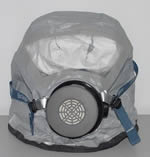
Escape respirators are designed to be used only in an emergency, and only to escape from a dangerous area to a safe area. There are several escape respirators on the market. Many of them use a hood with a neck seal instead of a facepiece. They are typically designed for one-time use for a short period, typically 15 minutes to 1 hour. They may be available in a variety of sizes and will fit most adults. Individuals with small or very large neck sizes may not be able to use some escape hood designs-check the supplier product information before purchasing.
Particulate Respirators
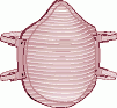
Particulate respirators are the simplest, least expensive, and least protective of the respirator types available. These respirators only protect against particles. They do not protect against chemicals, gases, or vapors, and are intended only for low hazard levels. The commonly known “N-95” filtering facepiece respirator is one type of particulate respirator, often used in hospital to protect against infectious agents. Particulate respirators are “air-purifying respirators” because they clean particles out of the air as you breathe. Even if you can’t see the particles, there may be too many in the air for this respirator to provide adequate protection.
Chemical Cartridge/Gas Mask Respirator

Gas masks are also known as “air-purifying respirators” because they filter or clean chemical gases and possibly particles out of the air as you breathe. This respirator includes a facepiece or mask, and a filter/cartridge (if the filter is in a metal shell it is called a “canister”). Straps secure the facepiece to the head. The cartridge may have a filter to remove particles (such as a biological weapon), charcoal (to remove certain chemicals), both, or other parts. When the user inhales, air is pulled through the filter.
Gas Masks are effective only if used with the correct cartridge or filter (these terms are often used interchangeably) for a particular biological or chemical substance. Selecting the proper filter can be a complicated process. There are cartridges available that protect against more than one hazard, but there is no “all-in-one” filter that protects against all substances. You need to know what hazards you will face in order to be certain you are choosing the right filters.
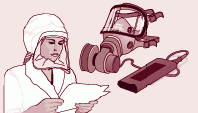
Powered Air-Purifying Respirator (PAPR)
Powered air-purifying respirators use a fan to blow air through the filter to the user. They are easier to breathe through and they need a fully charged battery to work properly. They use the same filters as gas masks, so you need to know what the hazard is, and how much of it is in the air.
Self-Contained Breathing Apparatus (SCBA)
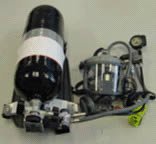
Self-Contained Breathing Apparatus (SCBA) is the respirator commonly used by firefighters. These use their own air tank to supply clean air, so you don’t need to worry about filters. They also protect against higher concentrations of dangerous chemicals. However, they are very heavy (30 pounds or more), and require very special training to use and to maintain them. Also, the air tanks typically last an hour or less depending upon their rating and how hard you are breathing.
The following questions and answers provide additional information for use in selecting and using gas mask and escape respirators.
At the end of this Fact Sheet, you will find a list of questions you should ask before purchasing a Gas Mask or Escape Respirator.
Can I buy any Gas Mask or Escape Respirator and expect it to protect me from anything that might happen?
These respirators must be selected for protection against a specific hazard.
The cautions, limitations and restriction of use provided with the respirator must be strictly followed. If your mask does not make a tight seal all the way around your face when you inhale, you may breathe contaminated air that leaks around the edges of the face seal. Anything that prevents the face mask from fitting tightly against your face, such as a beard or long sideburns, may cause leakage. Some respirators come in different styles and sizes, and fit different people differently because people’s faces have different shapes. You also need training to know how to correctly put the mask on and wear it correctly. This information should be provided by the supplier of the respirator.
If I have the right cartridges/filters for a certain hazard, and my mask fits, will they always protect me against that hazard?
Gas Masks and Escape Respirators reduce exposure to the hazard, but if the exposure is such that it goes beyond what the filter is capable of handling (either because the amount of toxic gas or particles is more than what the filter is designed to handle, or because the exposure lasts longer than what the filter is designed to handle), the filter may not be effective in providing required protection. Also, there may be a small amount of leakage even if the fit of the respirator has been tested. If so, and if there is large amount of a toxic chemical in the outside air, even that small leakage can be dangerous.
Can anyone wear a respirator mask?
Breathing through a respirator is harder than breathing in open air. People with lung diseases such as asthma or emphysema, elderly people, and others may have trouble breathing. Some people with claustrophobia may not be able to wear a mask or hooded respirator. Some people with vision problems may have trouble seeing while wearing a mask or hood (there are special masks for people who need glasses).
Will a gas mask protect children?
There are a variety of problems with fit and use of respirators for children, especially small children and infants. For example, currently available masks are unlikely to fit the faces of small children and infants. As with respirator use by anybody, fit-testing, training, and proper use and maintenance are essential.
Will my cartridge/filter and respirator mask protect forever?
Cartridges, filters, and masks get old. Cartridges can have a limited life. If the filter cartridges that attach to the mask are outdated, have been open to the air or are damaged, you are not protected. Cartridges that contain charcoal or other chemicals for filtering the air should be in air-tight packages. If cartridges are open or not packed in air-tight packaging, they should not be used. Even cartridges in original packaging have expiration dates that should be checked before purchase. Also, over time your mask can get old and break down. Keep your mask in a clean, dry place, away from extreme heat or cold. Inspect it according to the manufacturers instructions.
If I wear a Gas Mask correctly, am I completely safe?
The filter cartridges protect against only certain inhaled airborne substances. Some dangerous chemicals are absorbed through the skin. Properly selected and worn gas masks and escape respirators must be combined with protective clothing to completely prevent injury from these chemicals.
Will a Gas Mask protect me if there is not enough oxygen in the air?
Gas Masks do not provide oxygen. If used in an environment with low oxygen levels, such as a fire, you are in danger of suffocation.
Will a Gas Mask protect me if there is a fire?
It’s important to read the manufacturer’s information if your main concern is to be able to escape from a smoke-filled building. Smoke particles can rapidly clog gas mask filters, and filters with special chemicals are needed to protect against carbon monoxide and other gases that may occur in a fire. Not all gas masks and escape respirators protect against these hazards. Some components, including hoods and facepieces, of many of the gas masks and escape respirators may melt if exposed to a fire.
Once I put on my Gas Mask or Escape Respirator, how long will it last?
That depends on how much filtering capacity the respirator has and the amount of hazard in the air – the more chemical or biological hazard in the air (higher concentration), the shorter the time your filter will last. There is no absolute time limit, and it will vary by each respirator model’s capacities. That’s why your emergency plan must include some idea of how to get to a safe area before the filtering capabilities of the mask runs out.
How do I know a respirator will protect me against the hazards it claims to protect against?
No agency in the U.S. tests and certifies respirators for use by the general public, however, the National Institute for Occupational Safety and Health (NIOSH) part of the Centers for Disease Control and Prevention (CDC), tests and certifies respirators for use by workers to protect against workplace hazards. Respirators certified by NIOSH will say “NIOSH Approved” and may have a certification number. However, NIOSH only certifies respirators against specific hazards. Just because a respirator is certified does not mean it will protect against ALL hazards. NIOSH-certified respirators are supplied with Approval Labels that identify the hazards that the respirator is approved to protect against. If you are buying a respirator, you should check the Approval Label to be sure that it has been certified against the hazards you want protection against.
The Questions You Should Ask About Any Respirator You Are Considering Purchasing
- What protection (which chemicals and particles, and at what levels) does the escape hood provide?
- Is there more than one size?
- How do I know if the gas mask or escape hood will fit?
- What type of training do I need?
- Has the escape hood been tested against claims for protection such as biological agents, chemical warfare agents, toxic industrial chemicals, and radioactive dust particles?
- Who performed the testing, what were the tested levels, and test durations?
- Is the escape hood certified by an independent laboratory or government agency?
- Are there any special maintenance or storage conditions?
- Will I be able to talk while wearing the respirator?
- Does the hood restrict vision or head movement in any way?
- Can I carry the device in the trunk of my automobile?
- Is a training respirator available?
- Can I use the escape hood more than one time?
- Can children wear the escape hood and get the expected protection?
Relevant to the 2019 Novel Coronavirus
Understanding Respiratory Protection Against SARS
SARS (severe acute respiratory syndrome) is a new respiratory illness that has been reported in Asia, North America, and Europe. SARS appears to spread primarily by close person-to-person contact with symptomatic individuals (e.g., persons with fever or respiratory symptoms). SARS can be spread by touching the skin of other people or objects contaminated with infectious droplets and then touching the eyes, nose, or mouth. Contamination occurs when someone with SARS coughs or sneezes droplets onto themselves, other people, or nearby surfaces. It also is possible that SARS can be spread further through the air by very small particles. This method is called airborne transmission, but investigations to date suggest that this type of transmission is unusual. It also is possible that SARS may be spread by other ways that are currently not known.
How can health care workers be protected from SARS?
Most transmission of SARS to health care workers appears to have occurred after close contact with SARS infected individuals. CDC has therefore issued interim infection control recommendations for health care and other institutional settings (see Updated Interim Domestic Infection Control Guidance in the Health-Care and Community Settings for Patients with Suspected SARS, Interim Domestic Guidance on the Use of Respirators to Prevent Transmission of SARS, and Transport of Patients with Suspected SARS.)
These guides recommend that health care workers entering the room of a SARS patient and medical transport workers transporting a patient with suspected SARS use the following:
- Standard precautions (e.g., hand hygiene)
- Contact precautions (e.g., use of gown and gloves for contact with the patient or their environment)
- Eye protection for all patient contact
- A respirator that is at least as protective as an N-95 respirator approved by the National Institute for Occupational Safety and Health (NIOSH)
Infectious material deposited on personal protective equipment may cause it to become a vehicle for direct or indirect transmission. Therefore, care is needed when removing personal protective equipment to avoid contaminating skin, clothing, and mucous membranes. Standard procedures for removal of personal protective equipment that minimize the potential for self-contamination should be developed based on the equipment used, and healthcare and transport workers should be trained in these procedures. Hand hygiene should be performed following the removal of personal protective equipment.
What is a respirator and what is a NIOSH-approved N-95 respirator?
A respirator is a personal protective device that is worn on the face, covers at least the nose and mouth, and is used to reduce the wearer’s risk of inhaling hazardous airborne particles (including dust particles and infectious agents), gases, or vapors. The many types of respirators available include (1) particulate respirators, which filter out airborne particles; (2) “gas masks,” which filter out chemicals and gases; (3) airline respirators, which use compressed air from a remote source; and (4) self-contained breathing apparatus, which include their own air supply. The category of particulate respirator can be further divided into (1) disposable or filtering facepiece respirators, where the entire respirator is discarded when it becomes unsuitable for further use due to excessive resistance, sorbent exhaustion, or physical damage; (2) reusable or elastomeric respirators, where the facepiece is cleaned and reused but the filter cartridges are discarded and replaced when they become unsuitable for further use; and (3) powered air purifying respirators (PAPRs), where a battery-powered blower moves the air flow through the filters.
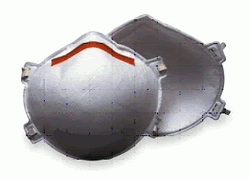
An N-95 respirator is one of nine types of disposable particulate respirators.
Particulate respirators are also known as “air-purifying respirators” because they protect by filtering particles out of the air as you breathe. These respirators protect only against particles—not gases or vapors. Since airborne biological agents such as bacteria or viruses are particles, they can be filtered by particulate respirators.
Respirators that filter out at least 95% of airborne particles during “worse case” testing using a “most-penetrating” sized particle are given a 95 rating. Those that filter out at least 99% receive a “99” rating. And those that filter at least 99.97% (essentially 100%) receive a “100” rating.
Respirators in this family are rated as N, R, or P for protection against oils. This rating is important in industry because some industrial oils can degrade the filter performance so it doesn’t filter properly.* Respirators are rated “N,” if they are Not resistant to oil, “R” if somewhat Resistant to oil, and “P” if strongly resistant (oil Proof). Thus, there are nine types of disposable particulate respirators:
- N-95, N-99, and N-100;
- R-95, R-99, and R-100;
- P-95, P-99, and P-100
NIOSH uses very high standards to test and approve respirators for occupational uses. NIOSH-approved disposable respirators are marked with the manufacturer’s name, the part number (P/N), the protection provided by the filter (e.g., N-95), and “NIOSH.” This information is printed on the facepiece, exhalation valve cover, or head straps. View a listing of all NIOSH-approved disposable respirators. If a disposable respirator does not have these markings and does not appear on one of these lists, it has not been certified by NIOSH. NIOSH also maintains a database of all NIOSH- approved respirators regardless of respirator type on the Certified Equipment List.
More detailed respirator information has been published by NIOSH, CDC and by the Occupational Safety and Health Administrationexternal icon (OSHA).
*The SARS virus has a “shell” composed of lipids, which are fats and oils. However, the amount of fat and oil in these tiny virus particles is extremely low and is not enough to affect the filter in the N-series respirator. Thus the N-series respirators such as N-95 will protect against SARS exposure.
Can health care workers use respirators other than N-95 to protect against SARS?
Yes, workers can wear any of the types of particulate respirators for protection against SARS—if they are NIOSH-approved and if they have been properly fit-tested and maintained. All of the NIOSH-approved particulate respirators protect workers against SARS as effectively as the N-95 respirators.
A respirator will work only if it is used correctly. Thus the key elements for respiratory protection are fit-testing and training of each worker in the use, maintenance, and care of the respirator. NIOSH considers each of the nine types of disposable particulate
respirators to have similar fit characteristics. Therefore, when a worker is caring for or transporting SARS patients, having a NIOSH-approved respirator that fits well is much more important than whether the respirator is an N-95 or one of the other eight types of disposable particulate respirators.
In health care settings, the use of respirators by workers is regulated under the Occupational Safety and Health Administration (OSHA) standard for respiratory protection. The OSHA standard sets requirements for the fit-testing of respirators to ensure a proper seal between the respirator’s sealing surface and the wearer’s face. The OSHA standard also contains requirements for determining that workers can use respirators safely, for training and educating employees in the proper use of respirators, and for maintaining respirators properly. NOTE: Fit-testing and the other OSHA-required procedures are absolutely essential to assure that the respirator will provide the wearer with required protection. View detailed information on respiratory programsexternal icon, including fit test procedures.
Why are N-95 respirators most often recommended for SARS?
The CDC Guidelines for Isolation Precautions in Hospitals recommends that health care workers protect themselves from any disease spread through the air (airborne transmission) by wearing a respirator at least as protective as a fit-tested N-95 respirator.† These guidelines were written before SARS was discovered, but they have been used to protect against other airborne diseases such as tuberculosis.
†Although N-95 respirators are sold outside the United States, other particulate respirators are also available. If you live in another country, your country may have its own standards for particulate respirators. The particulate respirators may have different names than those certified by NIOSH in the United States. If these respirators pass testing programs comparable to those used for N-95 respirators, they should protect against SARS as well as the N-95 respirators.
Can I use a respirator with an exhalation valve?
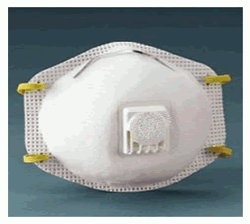
Usually, yes. An exhalation valve reduces excessive dampness and warmth in the mask from exhaled breath.
The valve opens to release exhaled breath and closes during inhalation so that inhaled air comes through the filter. Health care workers may wear respirators with exhalation valves unless the patient has a medical condition (such as an open wound) for which a health care worker would normally wear a surgical mask to protect the patient. Similarly, respirators with exhalation valves should not be placed on a patient to contain droplets and prevent spread of infectious particles; surgical masks are adequate for this purpose.
How often do disposable respirators need to be replaced?
Once worn in the presence of a SARS patient, the respirator should be considered potentially contaminated with infectious material, and touching the outside of the device should be avoided. Upon leaving the patient’s room, the disposable respirator should be removed and discarded, followed by hand hygiene.
If a sufficient supply of respirators is not available, healthcare facilities may consider reuse as long as the device has not been obviously soiled or damaged (e.g., creased or torn). Data on reuse of respirators for SARS are not available. Reuse may increase the potential for contamination; however, this risk must be balanced against the need to fully provide respiratory protection for healthcare personnel.
If N-95 disposable respirators are reused for contact with SARS patients, implement a procedure for safer reuse to prevent contamination through contact with infectious droplets on the outside of the respirator.
Consider wearing a loose-fitting barrier that does not interfere with fit or seal (e.g., surgical mask, face shield) over the respirator.
- Remove the barrier upon leaving the patient’s room and perform hand hygiene. Surgical masks should be discarded; face shields should be cleaned and disinfected.
- Remove the respirator and either hang it in a designated area or place it in a bag. (Consider labeling respirators with a user’s name before use to prevent reuse by another individual.)
- Use care when placing a used respirator on the face to ensure proper fit for respiratory protection and to avoid contact with infectious material that may be present on the outside of the mask.
- Perform hand hygiene after replacing the respirator on the face.
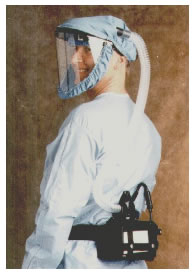
My hospital uses powered air-purifying respirators (PAPRs). Will they protect me from SARS?
Yes. PAPRs use HEPA filters (high-efficiency particulate air filters), which are as efficient as P-100 filters and will protect against SARS. PAPRs provide a higher level of protection than disposable respirators. Health care facilities in some SARS-affected areas have used higher levels of respiratory protection, including PAPRs, for persons present during aerosol-generating medical procedures such as bronchoscopy on SARS patients. When PAPRs are used, their reusable elements should be cleaned and disinfected after use and the filters replaced in accordance with manufacturer’s recommendations. All used filters should be considered potentially contaminated with infectious material and must be safely discarded.
Do surgical masks provide protection against SARS?
Surgical masks are not designed for use as particulate respirators and do not provide as much protection as an N-95 respirator. Most surgical masks do not effectively filter small particles from air and do not prevent leakage around the edge of the mask when the user inhales.
If surgical masks do not protect against airborne diseases, why are surgical masks suggested for use against SARS when no N-95 respirators are available?
Surgical masks are recommended only as a last resort for health care and medical transport workers exposed to SARS patients when no NIOSH-approved respirator equivalent to or greater than the N-95 is available. SARS appears to be transmitted mainly through direct contact with infectious materials (including large respiratory particles), and surgical masks will provide barrier protection against droplets that are considered to be the primary route of SARS transmission. However, surgical masks may not adequately protect against aerosol or airborne particles, primarily because they do not effectively filter small particles from the air, they allow leakage around the mask, and they cannot be fit tested. Because scientists cannot currently rule out the spread of SARS through the air, CDC recommends a NIOSH-approved respirator equivalent to or greater than the N-95.
Surgical masks may also be placed on patients with communicable conditions like SARS to contain respiratory droplets and prevent spread of infectious particles.
I don’t work with SARS patients. Should I wear a respirator while I am at work or in public?
Both CDC and the World Health Organization (WHO) recommend respirator use for the following workers only:
- health care workers entering the room of a patient with SARS
- medical transport workers transporting patients with suspected SARS
Respirators are not routinely needed (by staff or visitors) in other parts of hospitals or other health care facilities where there is no direct contact with patients.
Outside the health care and medical transport settings, CDC does not recommend the routine use of respirators. Most people who develop SARS become infected through contact with other people who are ill with SARS?not by breathing contaminated air. If a person does contact the SARS virus, it is most likely to be on a surface such as a door knob. The best protection from SARS in public places, (including workplaces other than health care and medical transport settings) is to wash your hands frequently and avoid touching your eyes or nose.



